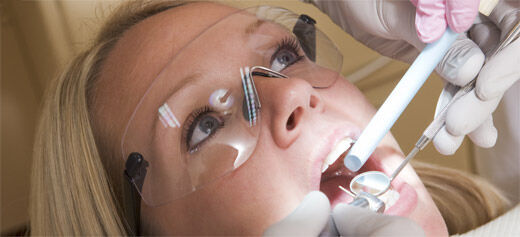
Researchers at the University of Leeds have discovered a pain-free way of tackling dental decay.
The pioneering treatment promises to transform the approach to filling teeth forever.
Tooth decay begins when acid produced by bacteria in plaque dissolves the mineral in the teeth, causing microscopic holes or 'pores' to form. As the decay process progresses these micro-pores increase in size and number. Eventually the damaged tooth may have to be drilled and filled to prevent toothache, or even removed.
The very thought of drilling puts many people off going to see their dentist, whether or not they actually need treatment. This tendency to miss check-ups and ignore niggling aches and pains means that existing problems get worse and early signs of decay in other teeth are overlooked.
It's a vicious cycle, but one that can be broken, according to researchers at the University of Leeds who have developed a revolutionary new way to treat the first signs of tooth decay. Their solution is to arm dentists with a peptide-based fluid that is literally painted onto the tooth's surface. The peptide technology is based on knowledge of how the tooth forms in the first place and stimulates regeneration of the tooth defect.
"This may sound too good to be true, but we are essentially helping acid-damaged teeth to regenerate themselves. It is a totally natural non-surgical repair process and is entirely pain-free too," said Professor Jennifer Kirkham, from the University's School of Dentistry, who has led development of the new technique.
The 'magic' fluid was designed by researchers in the University of Leeds' School of Chemistry, led by Dr Amalia Aggeli. It contains a peptide known as P 11-4 that - under certain conditions - will assemble together into fibres. In practice, this means that when applied to the tooth, the fluid seeps into the micro-pores caused by acid attack and then spontaneously forms a gel. This gel then provides a 'scaffold' or framework that attracts calcium and regenerates the tooth's mineral from within, providing a natural and pain-free repair.
The technique was recently taken out of the laboratory and tested on a small group of adults whose dentist had spotted the initial signs of tooth decay. The results from this small trial have shown that P 11-4 can indeed reverse the damage and regenerate the tooth tissue.
"The results of our tests so far are extremely promising," said Professor Paul Brunton, who is overseeing the patient testing at the School of Dentistry. "If these results can be repeated on a larger patient group, then I have no doubt whatsoever that in two to three years time this technique will be available for dentists to use in their daily practice."
"The main reason that people don't go to the dentist regularly is fear. If we can offer a treatment that is completely non-invasive, that doesn't involve a mechanical drill, then we can change that perceived link between dental treatment and pain. This really is more than filling without drilling, this is a novel approach that enables the patients to keep their natural teeth!"
The study is being funded by credentis ag who have licensed the technology and are preparing to introduce P11-4 to dentists worldwide.
For further information:
University of Leeds press office 0113 343 4031 or email pressoffice@leeds.ac.uk